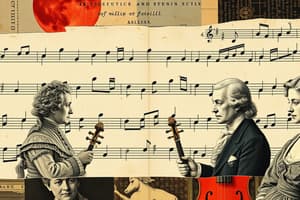Podcast
Questions and Answers
Although Haydn spent most of his time in Hungary, he often traveled to ___________________, where his music was performed often and greatly admired.
Although Haydn spent most of his time in Hungary, he often traveled to ___________________, where his music was performed often and greatly admired.
London
Which of the following statements about Beethoven is true?
Which of the following statements about Beethoven is true?
- Was a brilliant pianist
- All answers are correct (correct)
- Began to feel the first symptoms of deafness in his twenty-ninth year
- Was self-educated and had read widely, but was weak in elementary arithmetic
Which of the following statements is NOT true?
Which of the following statements is NOT true?
- In a theme-and-variations movement, a basic musical idea is repeated over and over and is changed each time
- The form called theme and variations is widely used in the classical period, either as an independent piece or as one movement of a symphony, sonata, or string quartet
- The recapitulation section is an important way for a composer to develop variations in a theme-and-variations form (correct)
- Each variation in a theme-and-variations form is unique and may differ in mood from the theme
Beethoven's sixteen _________________ are generally considered among the greatest music ever composed.
Beethoven's sixteen _________________ are generally considered among the greatest music ever composed.
The classical string quartet is a musical composition for
The classical string quartet is a musical composition for
The three main sections of a sonata-form movement are often followed by a concluding section known as the
The three main sections of a sonata-form movement are often followed by a concluding section known as the
Which of the following characteristics is NOT typical of the music of the classical period?
Which of the following characteristics is NOT typical of the music of the classical period?
The most important form of classical chamber music is the
The most important form of classical chamber music is the
What following technique did Beethoven use more extensively in his late works?
What following technique did Beethoven use more extensively in his late works?
The sonata-rondo
The sonata-rondo
The usual order of movements in a classical symphony is
The usual order of movements in a classical symphony is
Which of the following statements is NOT true?
Which of the following statements is NOT true?
In the exposition of a sonata-form movement
In the exposition of a sonata-form movement
Which of the following statements is NOT true?
Which of the following statements is NOT true?
In the classical period, comic operas sometimes
In the classical period, comic operas sometimes
Each successive variation in a theme with variations
Each successive variation in a theme with variations
The first movement of a classical symphony is almost always fast, and in __________ form.
The first movement of a classical symphony is almost always fast, and in __________ form.
The minuet is in ____________ meter.
The minuet is in ____________ meter.
Which of the following is NOT true of the symphony?
Which of the following is NOT true of the symphony?
Mozart composed his Requiem
Mozart composed his Requiem
Along with his symphonies, Haydn's _______ are considered his most important works.
Along with his symphonies, Haydn's _______ are considered his most important works.
A symphony is a
A symphony is a
The scherzo differs from the minuet in that it
The scherzo differs from the minuet in that it
The main theme of the rondo
The main theme of the rondo
Composers in the classical period took middle-class tastes into account by
Composers in the classical period took middle-class tastes into account by
Which of the following is NOT a characteristic of the minuet?
Which of the following is NOT a characteristic of the minuet?
The string quartet
The string quartet
Haydn was a prolific composer, as demonstrated in part by his 68 string quartets and 104
Haydn was a prolific composer, as demonstrated in part by his 68 string quartets and 104
A brilliant solo section in a concerto designed to display the performer's virtuosity is called
A brilliant solo section in a concerto designed to display the performer's virtuosity is called
Which of the following statements is NOT true?
Which of the following statements is NOT true?
The usual order of movements in a classical string quartet is
The usual order of movements in a classical string quartet is
Which of the following is NOT a characteristic of Haydn's music?
Which of the following is NOT a characteristic of Haydn's music?
In the recapitulation of a sonata-form movement
In the recapitulation of a sonata-form movement
Which of the following is NOT one of Mozart's three masterpieces of Italian opera?
Which of the following is NOT one of Mozart's three masterpieces of Italian opera?
The Third Symphony of Beethoven was originally composed to commemorate the deeds of _____ as the embodiment of heroism and democratic ideals.
The Third Symphony of Beethoven was originally composed to commemorate the deeds of _____ as the embodiment of heroism and democratic ideals.
Flashcards are hidden until you start studying
Study Notes
Haydn and Music Reception
- Haydn frequently traveled to London, where his music gained significant admiration.
Beethoven's Legacy
- Beethoven was renowned as a brilliant pianist and a self-educated composer who struggled with arithmetic.
- His emerging deafness began at the age of twenty-nine, impacting his later compositions.
Classical Musical Forms
- Theme and variations is a prevalent form during the classical period, allowing unique interpretations of a primary idea.
- The recapitulation in sonata form does not specifically aid in developing variations.
Importance of String Quartets
- Beethoven's sixteen string quartets are celebrated as significant works in classical music.
- The classical string quartet consists of two violins, viola, and cello, forming the core of chamber music.
- Haydn's body of work also includes a substantial number of string quartets.
Structure of Sonata Form
- Sonata-form movements typically follow a structure of exposition, development, and recapitulation, often concluding with a coda.
- In the exposition, the second theme is introduced in a distinct key.
Characteristics of Classical Music
- Classical period melodies are memorable, and compositions display a variety of rhythmic patterns.
- The music is generally homophonic, contrasting with polyphonic attributes.
Symphony Composition
- The standard movement arrangement in a classical symphony includes fast, slow, dance-related, and fast movements.
- A symphony is defined as a sonata for orchestra and does not involve solo instruments.
Notable Compositional Techniques
- Fugal counterpoint was more prominently used by Beethoven in his later works.
- The sonata-rondo form combines the distinct features of rondo and sonata forms, retaining a memorable theme.
Comic Operas and Social Commentary
- Comic operas during the classical period often addressed middle-class themes and humorously criticized the aristocracy.
Variational Techniques
- Variations maintain certain elements of the original theme, while often presenting in a new key.
Meter and Form Variability
- The minuet is characterized by triple meter and follows an ABA structure, differentiating itself from the quicker scherzo.
Mozart's Contributions
- Mozart's Requiem was commissioned by a stranger and is not merely an exercise for his compositional practice.
- Among Mozart's masterpieces, "Orfeo" is not among the recognized trio of his Italian operas.
Influence of Political Context
- The Third Symphony by Beethoven originally honored Napoleon Bonaparte, symbolizing heroism and democratic ideals.
- Comic operas reflect the shifting societal dynamics of the classical period, often mocking the aristocracy and their conventions.
Studying That Suits You
Use AI to generate personalized quizzes and flashcards to suit your learning preferences.




